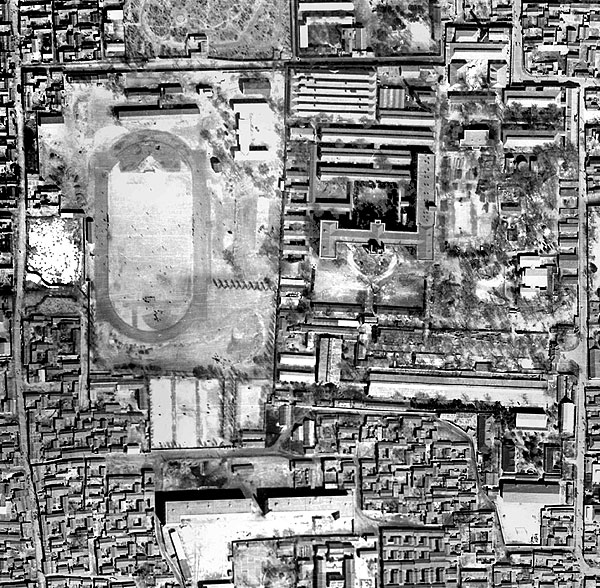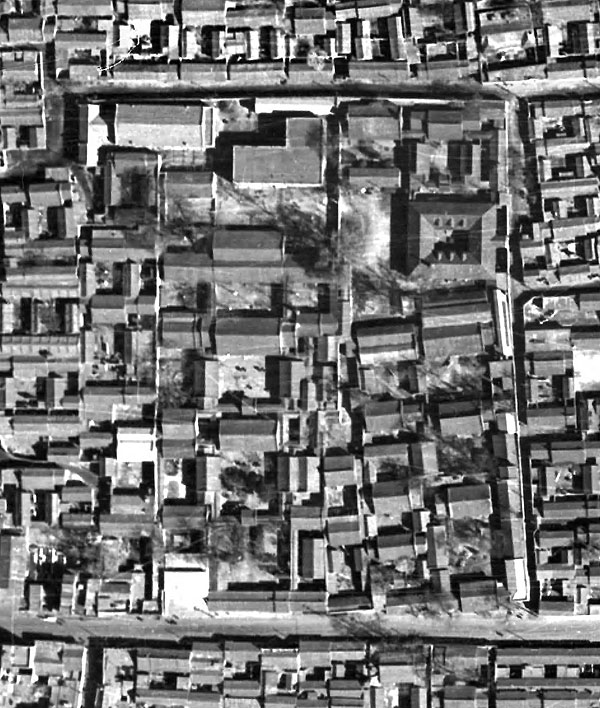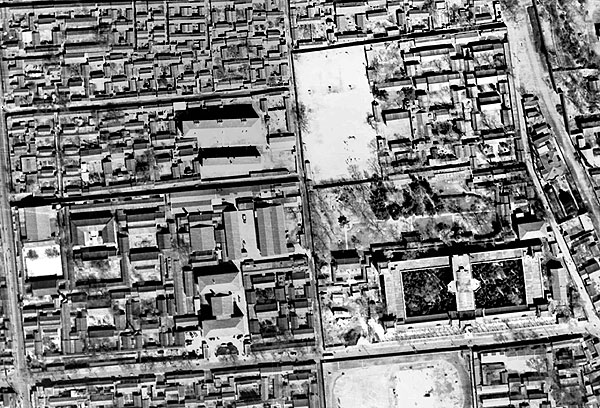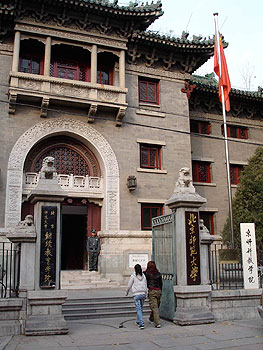|
||||||||
|
ARTICLESHidden Mansions: Beijing from the Air (Part I)Sang Ye and Geremie R. BarméOver the years since the fall of the last dynasty, the Princely Mansions of Beijing have been employed for various uses. Deprived of royal emoluments, the descendants of the old aristocracy faced poverty and, as the Republic unfolded, were forced to divest themselves of their private riches as well as of their considerable properties to survive. The stories of the selling off and evisceration of the Princely Mansions of the imperial era describe another history of modern Beijing (Beiping). The mansions would, at different times, provide vast residential properties for influential individuals, office space for government agencies, sites for new schools and universities, retreats for privileged members of the power-holding elite and even sports grounds for public use. While their mystique would occasionally be invaded by a more public gaze, many of the mansions remained as secretive as they were during the imperial era. In this essay, we continue our earlier work on the fate of the Princely Mansions of Beijing (see China Heritage Quarterly, Issue 12, December 2007). Herewith we introduce a number of the former Princely Mansions of Beijing and offer, literally, a bird's eye view of them, both in terms of their history and of their physical remains. The second half of this essay will appear under Articles in Issue 17 (March 2009) of our quarterly. The photographs accompanying this essay are taken from a larger aerial portrait of the old city of Beijing made in 1959. Featuring the area within what is today the Second Ring Road of the Chinese capital, and some of the outlying suburban districts beyond the then still extant Ming-era city walls, this 'aerial portrait' of Beijing was created by the Survey and Mapping Bureau of the General Logistics Department (Zongcan Cehui Ju) of the People's Liberation Army over the spring months of 1959, prior to the celebration of the tenth anniversary of the People's Republic of China. More crucially, this was prior to the systematic destruction of the walled integument of the ancient city. The images were made at a ratio of 1: 2000. The aim of this exercise was not limited to creating an overall picture of Beijing, but to provide material for the making of a 3D model of the city for various uses. An earlier aerial portrait of the city was made in 1951 but, at a ratio of 1:25000, the results were far from ideal. The dozens of images made in 1959 have been joined into a seamless overview of the city by the Survey and Mapping Institute of Beijing (Beijing Shi Cehui Yuan Hangce Yaogan Zhongxin), which obtained them in March 2006. Coordinates from Google Earth are provided in the captions of the images so that readers can compare the photographs taken in 1959 with recent satellite images of Beijing. The Princely Mansions mentioned in this essay were the official residences of princes of various rank, the main ones being princes of the first rank (qinwang), of the second rank (junwang), and of the third rank (beile). The Mansions of Prince Guo and Prince Cheng The north-south street on the left-hand side of the image is Xizhi Men South Street (Xizhi Men Nan Xiaojie), while that on the right is Yuyou Hutong. The east-west street to the top of the image is Hou Guangping Hutong, while that on the bottom is Zhumao Chang, and other alleys. This area is now part of Ping'an Li West Avenue (Ping'an Li Xi Dajie). For a recent satellite image, see Google Earth: 39°55'57.55" N 116°21'18.22" E. The left side of the image which shows a sports field and residential housing was originally Prince Guo's Mansion (later the mansion of Prince Duan). The right side with its modern structures and parklands were once Prince Cheng's Mansion (also known as the Ling Residence). The two mansions were separated by an alleyway.  Prince Duan and his retinue, late-nineteenth century. Reprinted in Gu Changjiang and Shen Hong, eds, Lao zhaopianzhongde Da Qing wangfu [Princely Mansions of the Great Qing in Old Photographs], Beijing: Wenhua Yishu Chubanshe, 2006. Prince Guo's Mansion in the Qing dynasty: Yunli, the seventeenth son of the Kangxi Emperor, was enfeoffed as Prince Guo at the start of the Yongzhen reign period (1720s). He played a central role in imperial politics and, by the advent of the Qianlong reign in 1736, he was a leading court official. As with other princely mansions, and the sliding scale of princely investiture (except for hereditary titles, princely ranks rose and fell according to many factors from imperial favour to personal ability), this mansion was bestowed upon other princes of rank and renamed a number of times during the later reigns of the Qing. During the Jiaqing reign (1796-1820), it was renamed Prince Duan's Mansion (actually, it should have been called Prince Rui's Mansion, but a copyist's error led to in the name Duan being used instead). After an inconspicuous career, during the 1890s Prince Duan (Zaiyi) became influential at court, and he was a leading conservative opponent to the reforms enacted by the Guangxu Emperor in 1898. As a champion of reaction he found favour with the Empress Dowager Cixi, who resumed power over the court and put a bloody halt to the reforms. Presumed to have plotted against the life of the Guangxu Emperor (Prince Duan is said to have hoped that his eldest son, Puchun, would ascend the throne), but pressured not to act by foreign diplomats and local officials, the prince became a key supporter of the xenophobic Boxer rebels, and he is said to have introduced them to the imperial court. Used as a Boxer base in 1900, Prince Duan's Mansion was razed by the Eight Allied Armies when they invaded the capital and quashed the rebellion. Thus implicated in the disastrous Boxer movement, Prince Duan was exiled to Ili after the failure of the uprising and the ignominious flight of the court. He remained in west China until the fall of the dynasty. Prince Duan is depicted as a craven courtier in the 1963 Hollywood film 55 Days at Peking in which he is played with camp relish by the Australian actor Robert Helpmann. Prince Cheng's Mansion in the Qing dynasty: Yunzhi was Kangxi's third son, and he was given the title Prince Cheng (Cheng junwang, prince of the second rank) in 1698, being promoted to prince of the first rank in 1709. Accused of various crimes in the following rein, he was demoted a rank and forced to quit his mansion. His official residence became first Prince Shen's Mansion and later Prince Zhi's Mansion, but with successive generations and demotions it was eventually reduced to being home to a lower-order prince (of the rank zhenguo gong), Puling, and was popularly known as the Ling Residence (Ling Gongguan). This mansion was built on a similar scale to that of the neighbouring Prince Duan Mansion. It too was destroyed during the Boxer conflict. The Republic: Following the 1911 Xinhai Revolution and the establishment of the Republic of China the following year, the grounds of these two mansions were used by various new educational institutions. These included: Jingshi Yitu Xuexiao, Beiping Shifan Xuexiao, Beiping Gongye Xuexiao, Beiyang Daxue Beipingbu Gongxueyuan and Beiping Daxue Gongxueyuan. The People's Republic: In 1953, the area originally belonging to Prince Duan's Mansion was converted into a sports ground, the eastern sector becoming the student precinct of the Geology Institute of Beijing, the Western District Amateur Sports Academy and Guan Yuan Park. Given the history of Prince Duan and the Boxer Rebellion, the next phase in the history of this site is intriguing. In 1968, the area was requisitioned by the Office of the Central Committee of the Chinese Communist Party and a large wall was built around most of the area of the two former mansions. The wall contained a concealed walkway for guards and peep-holes for security surveillance. Inside, this compound became something of a 'secret garden' being planted with numerous trees and extensive vegetation. These gardens surrounded a newly built auditorium, offices and an outsized residence with cavernous bathrooms. It was established as the second headquarters for the Central Cultural Revolution Leading Group (Zhongyang wenge lingdao xiaozu). It was also made ready for use as an emergency centre of operations by the Central Committee in case of war. In light of these functions, an underground network of offices, meeting halls and an auditorium were constructed along with subterranean road and rail links that connected Guan Yuan with the Great Hall of the People and the Lake Palaces (Zhongnan Hai) headquarters of the Party and the State Council and further afield to the military command centre in the Western Hills. Hua Guofeng, the interregnum ruler of the Communist Party appointed by Mao Zedong, lived for a while in Guan Yuan. He vacated the place after lengthy negotiations and, in 1982, most of the area was rezoned as the China Youth and Childrens' Activity Centre (Zhongguo Shaonian Ertong Hudong Zhongxin). Another part of the area became offices for the Party's Central Committee Disciplinary Committee. The underground structures remain intact, but sealed. (For the relationship of Guan Yuan to the Beijing Underground and Project 519, see 'Beijing Underground' in China Heritage Quarterly, Issue 14, June 2008.) Today: The area around Guan Yuan is best known for its pet market, although it started out as a bird market in the 1990s. The keeping of birds, fish and dogs was for many years regarded as a habit related to the decadent Manchu Bannermen. Nowadays, they are part of the revived, and celebrated, culture of 'Ye Olde Beijing'. What remains of the original area occupied by the old princely mansions has become valuable residential real estate. Prince Xun's Mansion Prince Xun's Mansion. See also Google Earth: 39° 54'11.61" N 116° 22'14.81" E. Despite the changing functions of this property, Prince Xun's Mansion between Hou Niurou Wan in the north and Xi Rongxian Hutong to the south, to the south-east of Dongdan, is still one of the best-preserved mansions of its kind in the city. It has five interconnected courtyards arranged along three south-north axes. Prince Xun's Mansion in the Qing dynasty: Mianxun was a beizi, or prince of the third rank. He was the great-grandson of Prince Cheng, Yinmi, the twenty-fourth son of the Kangxi Emperor. The original Prince Xun's Mansion was located on Kuan Jie inside Anding Men in the northeast section of the old city of Beijing. It was relocated to Xi Rongxian Hutong in 1869, the original mansion being 'demoted' to become Princess Gulun's Residence (Gulun Gongzhu Fu), a mansion bestowed by the Xianfeng emperor on his daughter Rong'an. (Later the residence of Puju, the great grandson of Mianxun and coeval with Puyi, the last Qing emperor, it is also known as the Residence of Lord Ju, or Ju Gong Fu.) The Republic: In 1924, Puju sold the extensive residence to the director of the Jincheng Bank, Zhou Zuomin, who used it as a family home. The People's Republic: In 1952, in an act of patriotic generosity Zhou Zuomin handed over the residence to the Central People's Government for appropriate 'redeployment'. Zhou was a left-wing banker who, by this time, was principally resident in Shanghai, where he was a deputy director of the China Cooperative Bank. Initially, Prince Xun's Mansion was used as offices by the State Ministry of the Procurator (Guojia Jianchabu). Following Zhou's demise in 1955, the residence (as well as a large personal fortune) were bequeathed to the state. On the suggestion of Zhu De and Chen Yi, two famous Party leaders from Sichuan province, and with the support of Premier Zhou Enlai, this former princely mansion was converted into the Sichuan Restaurant (Sichuan Fandian). Over the following three decades, the Sichuan Restaurant was one of the finest dining places in Beijing, and it was frequented by Party-state leaders and fellow travellers (in particular those with a Sichuan connection: Zhu De, Chen Yi, Deng Xiaoping and Guo Moruo, although Zhou Enlai also often dined there) for whom it became something of a private club. In the early days of the Cultural Revolution, the high-level cadre club at Yangfeng Jiadao was closed, and the Sichuan Restaurant was put under the control of that club's leadership. Deng Xiaoping and his old comrade-in-arms, Liu Bocheng, frequented it during the twilight of the Mao era, from 1973 to 1977. Today: In 1995, the Sichuan Restaurant went into partnership with the Hong Kong businessman David Tang's China Club to become the exclusive Beijing China Club (Beijing Zhongguohui). As a private club it has to all effects and purposes been returned to the off-limits world in which it existed in the dynastic, Republican and high-Maoist eras. Although retaining elements of an older-style Beijing courtyard residence, the structure is overwhelmed by new buildings such as Cuiwei Dasha, that looms immediately to its north on Chang'an Boulevard. Prince Qing's Mansion and Prince Tao's Mansion Prince Qing's Mansion is located to the left-hand side of this image, while Prince Tao's Mansion is to the right. They are separated by Pine Street (Songshu Jie). Further to the right is Liuyin Street and next to it, just out of view, is Prince Gong's Mansion, the princely mansion par excellence. See Google Earth: 39°56'03.82" N 116°22'39.97" E. Prince Qing's Mansion in the Qing dynasty: The last Prince Qing was the Daoguang-era scholar Qishan (known in earlier English sources as Kishen), a member of the influential Borjigit clan, one of the hereditary princes whose forebearers were active from the earliest days of the Qing era. Qishan was a highly controversial figure, famous for his conciliatory role in the First Opium War and the treaty concluded after the hostilities that saw Hong Kong ceded to the British. He was demoted and exiled a number of times before his eventual death in 1854. Yikuang, who rose to prominence partly through his memorializing against Qishan, moved into Qishan's residence and, when he was promoted to become Prince Qing (as a second-rank prince), the place was rebuilt on the scale of a princely mansion. Yikuang was made an hereditary prince in 1898 and major renovations of the mansion continued. These included the building of a swastika-shaped pavilion and an opera theatre. With nearly 1000 jian (one jian being the bay or space between roof beams) it was the most spacious of all the princely mansions.  Entrance to Prince Qing's Mansion, 2006. Photo: GRB. The Republic: Following the 1911 Revolution and the fall of the Qing dynasty, Yikuang moved to the British concession in nearby Tianjin, where he died in 1918. His son Zaizhen and other relatives carved up the mansion to create three separate living areas, although Zaizhen himself moved to Tianjin in 1925 to live in what was known as the 'Tianjin Prince Qing Mansion', a property acquired from the former powerful court eunuch Zhang Xiangzhai (Xiaode Zhang). Thereafter, most of the old Beijing mansion was left uninhabited apart from rooms rented out to the middle school attached to the Catholic Fu-jen University. In 1940, Zaizhen sold the property to the Japanese-controlled North China Administrative Committee, and after the war it was confiscated by the Nationalist government. Thereupon, it served as the headquarters of the Beiping District Airforce and as offices for textbook editors in the employ of the Nationalist Ministry of Education. The People's Republic: Following 1949, the former site of Prince Qing's Mansion became the headquarters of the Weixu Military Region of Beijing-Tianjin. The buildings east of the central axis were demolished to make way for modern offices and dormitories. Thereafter, the grounds acted variously as the headquarters of the Beijing Military Region, Marshal Nie Rongzhen's official residence and the headquarters of the Weixu Military Region of Beijing, during which time there were constant demolitions and new building.
On 4 February 1971, the Weixu Military Region held its Spring Festival celebrations at the old opera theatre in the former mansion, during which there was a performance of the model Beijing Opera The Red Lantern (Hongdeng ji). Members of the opera troupe who were smoking backstage accidentally set the stage curtain alight and the theatre was destroyed in the resulting conflagration (superstitious observers noted that it was exactly a jiazi, or sixty-year cycle, since the ephocal Xinhai Revolution of 1911). Today, the mansion is occupied by the headquarters and dormitories of the Weixu Military Region United Logistics Department. Attempts to restore parts of the stricken mansion have been repeatedly frustrated. Prince Tao's Mansion: Originally, this was known as Prince Yu's Mansion, Prince Yu being Yunyu, the fifteenth son of the Kangxi Emperor. In 1898, Zaitao, the seventh son of Prince Chun (Yihuan), was adopted by Prince Zhong and inherited the title of prince (beile), at which time he moved into this mansion which henceforth was known as Prince Tao's Mansion (Tao Beile Fu).  Entrance to Prince Tao's Mansion, formerly Fu-jen University, 2006. Photo: GRB. Zaitao was the uncle of Aisin Gioro Puyi, the last emperor of the Qing dynasty whose reign title was Xuantong. Zaitao was a commander of the palace guard and, following the 1911 Revolution, he was regarded as the leader of the more progressive faction of the defunct nobility. After 1949, he was appointed as an adviser to the Cavalry Bureau (Mazheng Ju) of the General Logistics Department of the People's Liberation Army. Along with other members of the former nobility, he was also made a member of the National People's Congress and the National People's Political Consultative Congress. The numerous buildings and courtyards of Prince Tao's Mansion were, like those of many other mansions of a similar scale, arranged along three parallel axes, featuring four north-south interconnected courtyards. Most of the buildings were located in the northern precinct of the mansion, while the south featured a large ornamental garden. In 1925, Zaitao rented the mansion to Fu-jen University which used it for school buildings and dormitories. In consideration of the style and character of the surrounding structures—the other princely mansions, Bei Hai Park, the Imperial City and the nearby Forbidden City—the Catholic administrators of Fu-jen decided to commission a design for the new university buildings in what was then a popular hybrid Sino-Western style. In 1929, buildings designed by the Belgian architect Dom Adelbert Gresnight were constructed in the former princely garden. The main Republican-era building is still extant, although Fu-jen and Beijing Normal University were required to amalgamate in 1953 during the radical reordering of tertiary educational institutions. The former main building of Fu-jen became the Chemistry Department of Normal University. The northern buildings of the old mansion—latterly student dormitories—remain basically intact, although what was once Fu-jen Boys' High School became, in 1952, Beijing Number Thirteen Middle School. |